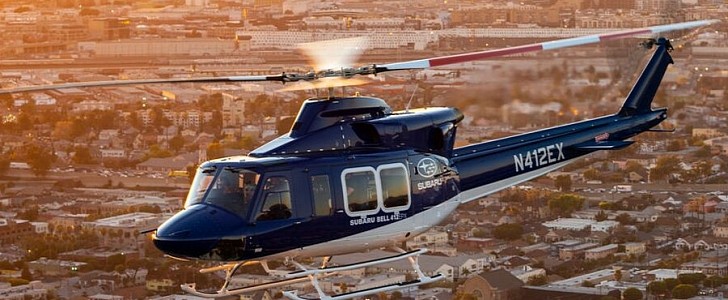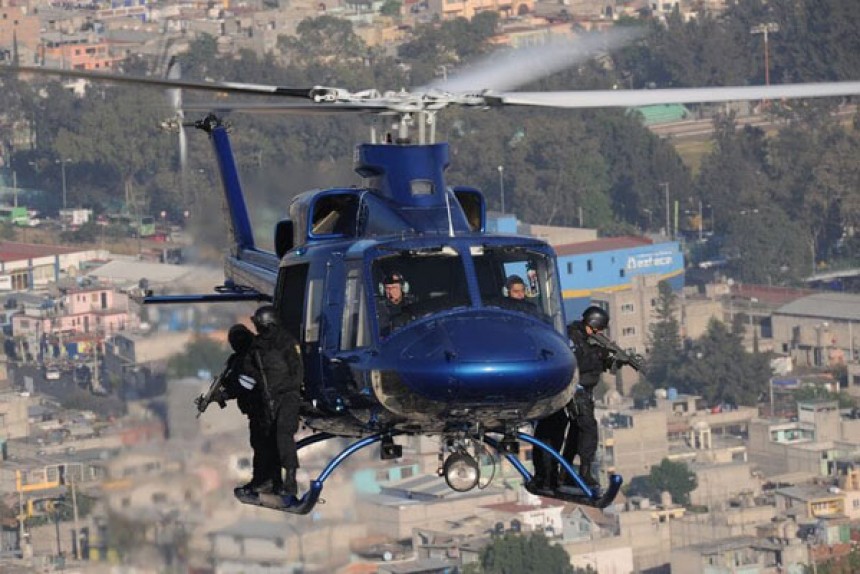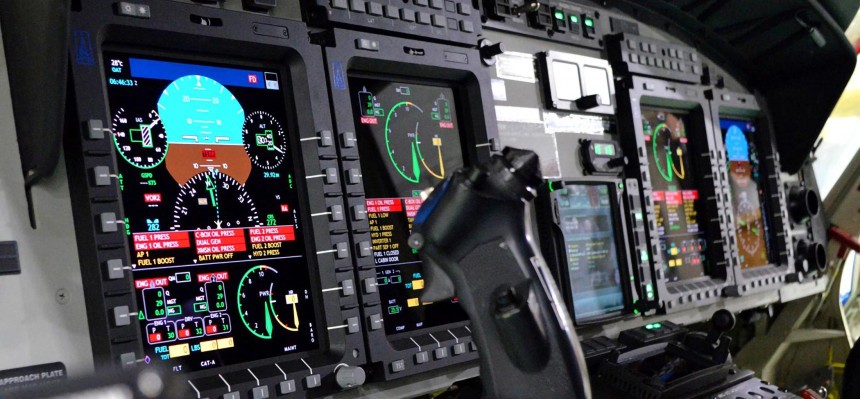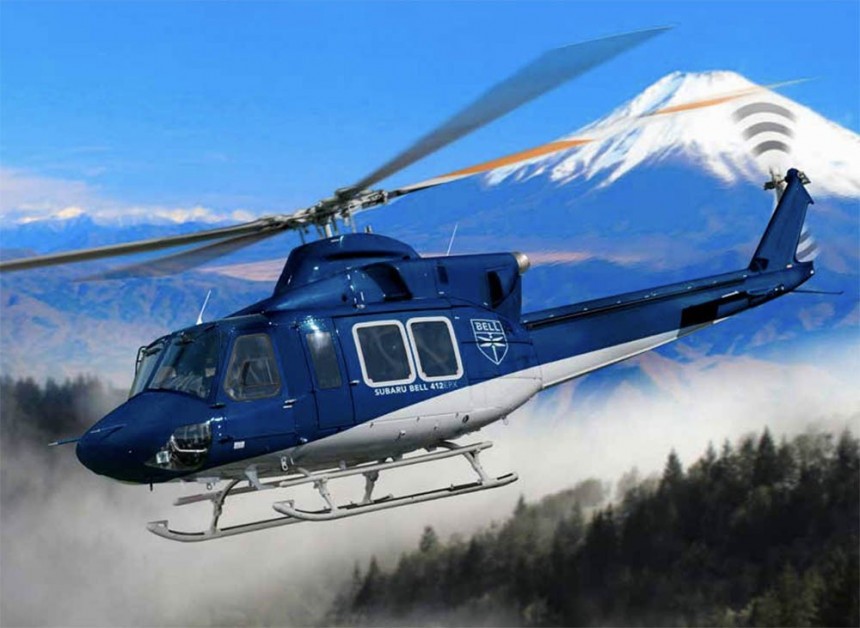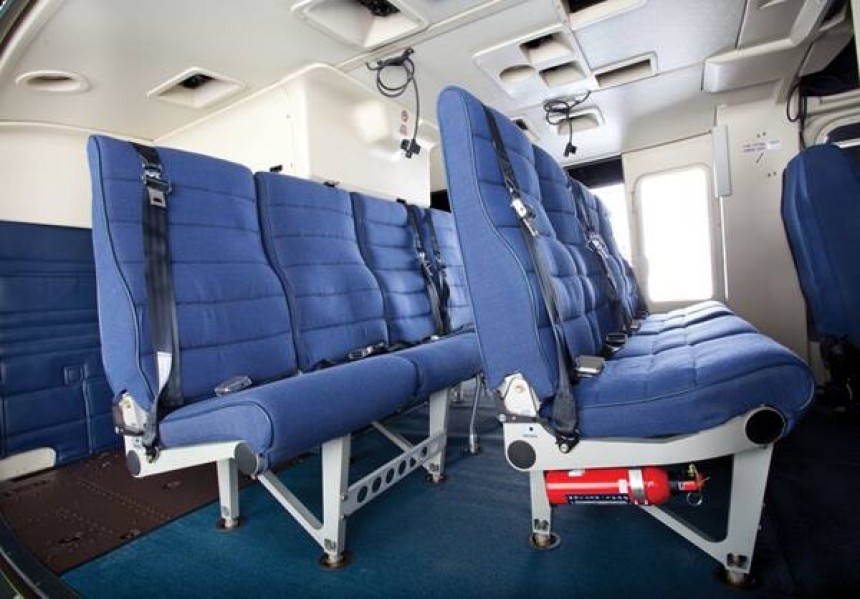If you were thoroughly disappointed with how unimpressive the release of the Subaru Impreza WRX and STI went last year, just remember that the former Fuji Heavy Industries has its hands in just about every facet of engineering.
There's almost always something to look forward to from this multi-billion dollar engineering team. And yes, these industries include helicopters. Built with the blessings of Bell Textron, the makers of the Famous UH-1 Iroquois, Subaru fully intends for their 412EPX to pull the brunt of the utility helicopter duties for the Japanese police and military.
Its first prototype helicopter under the Subaru moniker and not the old Fuji brand will be the 412EPX. The latest evolution in a UH-1- Huey lineage that's already in use with the Japanese Police and Self Defense Force.
It's important to remember that the American Bell 412 line of helicopters is already over 40 years old at this juncture, itself a derivative of the Bell 212, which originated from the U.S. Military's Huey derived CH-135 "Twin Huey."
So, outside of a shiny, new coat of paint, what's this Subaru manufactured example got that its American counterpart doesn't? As it happens, the answer needs to be explained in sections.
Starting with a brief historical recap, Subaru and Bell Textron have been on and off working partners since the early 1960s. Back when the original Bell UH-1 Iriquois helicopter was flying over Vietnam, Subaru, under the Fuji Heavy Industry moniker, was among the first to license-build Bell helicopters overseas.
One of the very first, the Fuji-Bell 204B, looked nearly identical to the American helicopter it was devised from. By 1995, the upgraded Fuji-Bell 205B was flying with the Japanese Civil Aviation Bureau (Ministry of Transportation). Moving into the 21st century, the next phase of the Fuji-Bell program was ready to take shape by the mid-2010s. Now under the same Subaru branding used with their passenger cars.
Work began on what we now call the Subaru 412EPX in at least 2014 and likely well before, with Subaru's official press release for the project coming in September 2015. The new helicopter is purpose-built for use with the Japanese Self Defense Forces as a utility chopper.
Powering this Japanese-American beast is a single electrically controlled Pratt & Whitney Canada PT6T Twin-Pac turboshaft engine with 11% more torque on offer over the normal Bell 412, thanks to an improved transmission. It's the same engine that powers the American AH-1Z Super Cobra and the Navalized AH-1J SeaCobra.
Safe to say, it's more than robust enough for non-combat operations. Or even light troop transport if the need arises. Inside the cockpit, the second generation of Bell's Basi-Pro glass display system enveloped the dashboard in a sea of clear, crips, liquid crystal panels that integrate all the operations of the aircraft into four large screens.
It incorporates a Garmin GTN-750 NAV/COM/GPS with high-resolution digital maps, a downside better than what you get with Apple Maps. The system is also synced to the helicopter's autopilot system, allowing for a certain level of autonomous operation. Loaded to around 10,500 pounds (4762.71 kg), including its own weight, Subaru-Bell reckons it can hover at a maximum altitude of between 13 and 15,000 feet (4572 meters).
A fascinating new feature on the 412EPX is the integrated "Fast Fin" located at the rear of the aircraft. This stabilizing element in close proximity to the tail rotor improves airflow around the tail boom and vertical fin. So just in case the 412EPX needs to escape in a hurry, there shouldn't be any issues maneuvering away from danger.
Inside the cabin, there are three options for a seating arrangement of 13, two of which come at no extra cost to the operator. These two include a Fabric covered folding seat variant with individual seat belts and a single strap shoulder harness. The other is Nylon covered bench seating arranged with one row of four rearward facing seats behind the crew, one row of five forward-facing seats, and two outward-facing benches.
Its first prototype helicopter under the Subaru moniker and not the old Fuji brand will be the 412EPX. The latest evolution in a UH-1- Huey lineage that's already in use with the Japanese Police and Self Defense Force.
It's important to remember that the American Bell 412 line of helicopters is already over 40 years old at this juncture, itself a derivative of the Bell 212, which originated from the U.S. Military's Huey derived CH-135 "Twin Huey."
So, outside of a shiny, new coat of paint, what's this Subaru manufactured example got that its American counterpart doesn't? As it happens, the answer needs to be explained in sections.
Starting with a brief historical recap, Subaru and Bell Textron have been on and off working partners since the early 1960s. Back when the original Bell UH-1 Iriquois helicopter was flying over Vietnam, Subaru, under the Fuji Heavy Industry moniker, was among the first to license-build Bell helicopters overseas.
One of the very first, the Fuji-Bell 204B, looked nearly identical to the American helicopter it was devised from. By 1995, the upgraded Fuji-Bell 205B was flying with the Japanese Civil Aviation Bureau (Ministry of Transportation). Moving into the 21st century, the next phase of the Fuji-Bell program was ready to take shape by the mid-2010s. Now under the same Subaru branding used with their passenger cars.
Work began on what we now call the Subaru 412EPX in at least 2014 and likely well before, with Subaru's official press release for the project coming in September 2015. The new helicopter is purpose-built for use with the Japanese Self Defense Forces as a utility chopper.
Powering this Japanese-American beast is a single electrically controlled Pratt & Whitney Canada PT6T Twin-Pac turboshaft engine with 11% more torque on offer over the normal Bell 412, thanks to an improved transmission. It's the same engine that powers the American AH-1Z Super Cobra and the Navalized AH-1J SeaCobra.
Safe to say, it's more than robust enough for non-combat operations. Or even light troop transport if the need arises. Inside the cockpit, the second generation of Bell's Basi-Pro glass display system enveloped the dashboard in a sea of clear, crips, liquid crystal panels that integrate all the operations of the aircraft into four large screens.
It incorporates a Garmin GTN-750 NAV/COM/GPS with high-resolution digital maps, a downside better than what you get with Apple Maps. The system is also synced to the helicopter's autopilot system, allowing for a certain level of autonomous operation. Loaded to around 10,500 pounds (4762.71 kg), including its own weight, Subaru-Bell reckons it can hover at a maximum altitude of between 13 and 15,000 feet (4572 meters).
A fascinating new feature on the 412EPX is the integrated "Fast Fin" located at the rear of the aircraft. This stabilizing element in close proximity to the tail rotor improves airflow around the tail boom and vertical fin. So just in case the 412EPX needs to escape in a hurry, there shouldn't be any issues maneuvering away from danger.
Inside the cabin, there are three options for a seating arrangement of 13, two of which come at no extra cost to the operator. These two include a Fabric covered folding seat variant with individual seat belts and a single strap shoulder harness. The other is Nylon covered bench seating arranged with one row of four rearward facing seats behind the crew, one row of five forward-facing seats, and two outward-facing benches.
That said, at the moment, the only operators of the type serve some role in the Japanese Government. Be it in self-defense or public utility capacity. According to official sources, an up-tiered VIP model with cushioned utility seating is also in the works.
So then, you may or may not be enthralled with Subaru's recent lineup of passenger cars. But you simply can't make the argument that they aren't making up for it, at least a little bit, with their ventures in other industries.
With this in mind, it's safe to say, as far as limited edition helicopters, it is at least more special than the dime a dozen American UH-1 "Huey" ancestor it's spawned from. But then again, they made so darn many of those, they're hardly special at all.
